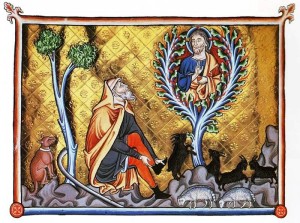In his sermon “On the Holiness of Christ’s Body,” John Keble, one of the founders of the Oxford Movement, emphasized the reverence and awe with which we ought to approach the Body of the Lord by comparing to the Burning Bush.
“For the Body of the Jesus Christ is part of Him: taken, as the Creed saith, into His Divine Person. We cannot think of it too religiously, we cannot speak of it with too much awe, we cannot behave toward it too reverentially. It is that, of which the burning bush, shewn to Moses in the Mount, was in some sort a type or figure. As the bush burned with fire, yet the bush was not consumed, so the Human Nature of our Lord Jesus Christ, and therein His blessed Body, hath the True Godhead ever abiding in it, and wonderfully imparting to it all its Fulness; yet doth it not therefore cease to be a true and real human Body, of the same nature, though without the same frailties and imperfections, as these our bodies, in which we live and move on earth.
Remember then, what was said to Moses when he drew near to gaze on the burning bush. “Put off thy shoes from thy feet, for the place whereon thou standest is holy ground.” And remember also how Moses behaved; he “hid his face, for he was afraid to look upon God.”
How much more ought we sinners to hide our faces, and evermore practice the very deepest reverence, when we draw near to our Lord’s Body, the living Temple of His Godhead, in the Holy Eucharist; when we think of that Sacrament; when we read or speak of it, when we do but hear it named, but more especially when we are preparing ourselves, and most especially of all, when we are preparing to touch, to taste, to eat and drink It. That which we there receive is a Temple: and the Lord is in His Holy Temple : let all the earth keep silence, hold its breath, as it were, before Him out of reverence and godly fear.
It is a Holy Fire; the Fire of the Lord. And as it is in the nature of fire to take up and change into itself all that it lays hold on, so our Lord’s gracious purpose is to change us, as it were, into part of Himself.
Pope Benedict XVI wrote:
What we are told about the the monks of Cluny, around the year one thousand, is particularly striking. Whenever they went to receive Communion, they took their shoes off. They knew that the burning bush was here, the mystery before which Moses, in the desert, sank to his knees. The form may change, but what has to remain is the spirit of adoration.
The Romanesque miniature shows Moses at the Burning Bush. The Bush forms a mandorla, a symbol of the Uncreated Light of God breaking through into out world, and the mandorla encloses a very Byzantine Christ giving a blessing. Like much Romaneque art, it contains a touching, simple detail: the dog on the far left. A shepherd of course would have a dog, and Romaneque artists showed a love for the animal creation.
